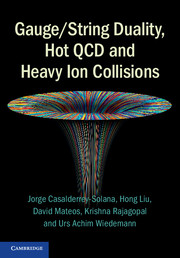Book contents
- Frontmatter
- Contents
- 1 Opening remarks
- 2 A heavy ion phenomenology primer
- 3 Results from lattice QCD at nonzero temperature
- 4 Introducing the gauge/string duality
- 5 A duality toolbox
- 6 Bulk properties of strongly coupled plasma
- 7 From hydrodynamics to far-from-equilibrium dynamics
- 8 Probing strongly coupled plasma
- 9 Quarkonium mesons in strongly coupled plasma
- 10 Concluding remarks and outlook
- Appendix A Green–Kubo formula for transport coefficients
- Appendix B Hawking temperature of a general black brane metric
- Appendix C Holographic renormalization, one-point functions, and a two-point function
- Appendix D Computation of the holographic stress tensor
- References
- Index
10 - Concluding remarks and outlook
Published online by Cambridge University Press: 05 July 2014
- Frontmatter
- Contents
- 1 Opening remarks
- 2 A heavy ion phenomenology primer
- 3 Results from lattice QCD at nonzero temperature
- 4 Introducing the gauge/string duality
- 5 A duality toolbox
- 6 Bulk properties of strongly coupled plasma
- 7 From hydrodynamics to far-from-equilibrium dynamics
- 8 Probing strongly coupled plasma
- 9 Quarkonium mesons in strongly coupled plasma
- 10 Concluding remarks and outlook
- Appendix A Green–Kubo formula for transport coefficients
- Appendix B Hawking temperature of a general black brane metric
- Appendix C Holographic renormalization, one-point functions, and a two-point function
- Appendix D Computation of the holographic stress tensor
- References
- Index
Summary
Since the purpose of heavy ion collisions is to study the properties of Quantum Chromodynamics at extreme temperature and energy density, any successful phenomenology must ultimately be based on QCD. However, as discussed in Chapter 2, heavy ion phenomenology requires strong coupling techniques not only for bulk thermodynamic quantities like the QCD equation of state, but also for many dynamical quantities at nonzero temperature, such as transport coefficients, relaxation times and quantities accessed by probes propagating through a plasma. By now, lattice-regularized QCD calculations provide well controlled results for the former, but progress on all the latter quantities is likely to be slow since one needs to overcome both conceptual limitations and limitations in computing power. Alternative strong coupling tools are therefore desirable. The gauge/string duality provides one such tool for performing nonperturbative calculations for a wide class of non-Abelian plasmas.
In this book we have mostly focused on results obtained within one particular example of a gauge/string duality, namely the case in which the gauge theory is N = 4 SYM or a small deformation thereof. One reason for this is pedagogical: N = 4 SYM is arguably the simplest and best understood case of a gauge/string duality. By now many examples are known of more sophisticated string duals of non-supersymmetric, nonconformal QCD-like theories that exhibit confinement, spontaneous chiral symmetry breaking, thermal phase transitions, etc.
- Type
- Chapter
- Information
- Gauge/String Duality, Hot QCD and Heavy Ion Collisions , pp. 398 - 402Publisher: Cambridge University PressPrint publication year: 2014



